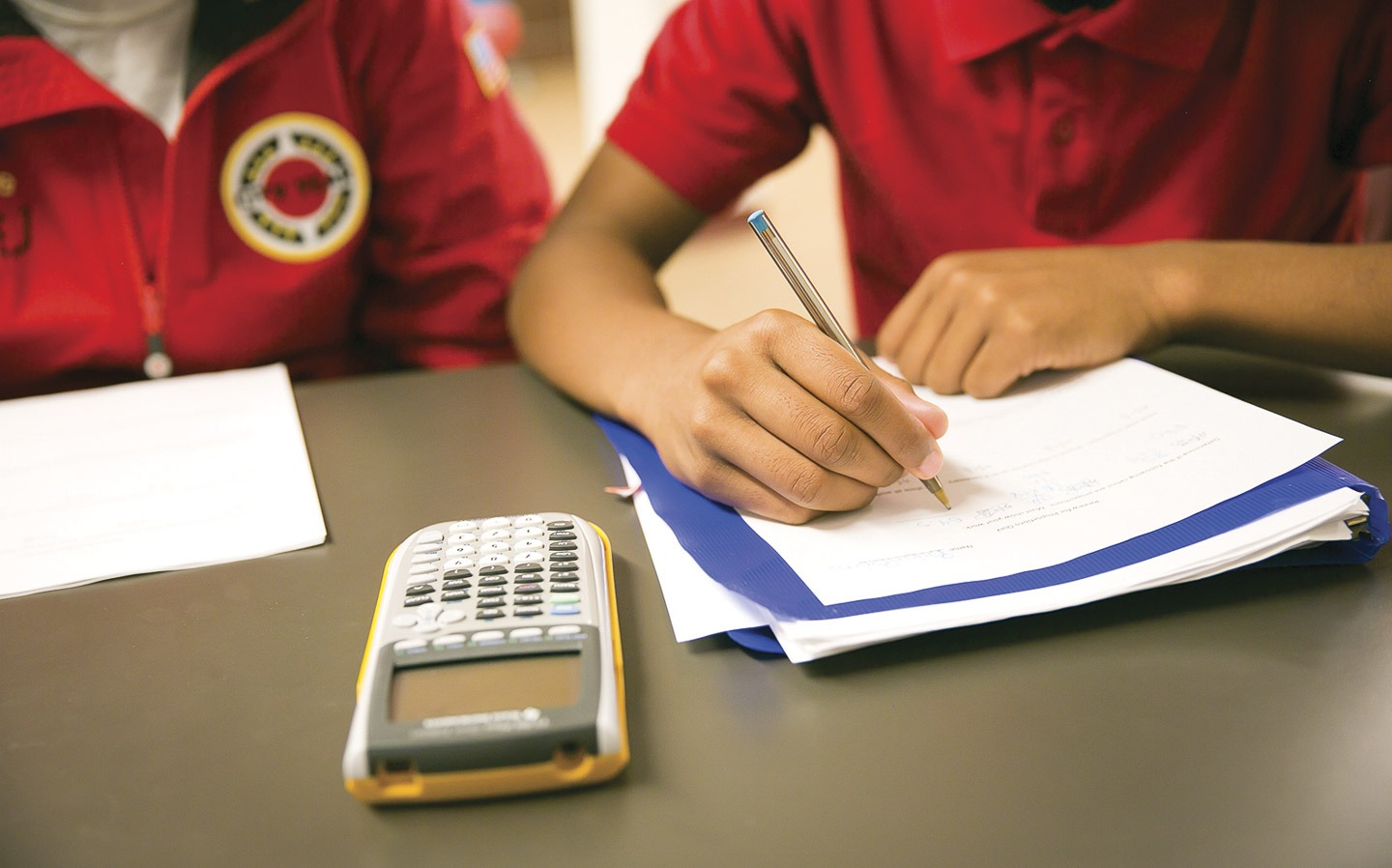How social-emotional supports build math confidence

Developing student success by blending academic and social-emotional support
Inside Rhode Island’s largest elementary school, four fifth-grade students gather around a small table scattered with worksheets and dice. The students lean in to listen to Ben Roth, a City Year Providence AmeriCorps member from Pueblo, Colorado, who moved across the country to serve at Carl G. Lauro Elementary School for the 2018-2019 school year.
Ben is explaining a game called Target1000 from a Do The Math curriculum book. The goal, he says, is to get as close to 1,000 as possible, without going above, by rolling the dice and multiplying the outcomes by factors of ten. Ben places the students in teams of two to compete against one another—and learn how to problem solve together. “Discuss with your partner which number you want to choose,” Ben says. The partners whisper, working together to select an answer. Two students giggle and give each other a thumbs up when they pick a winning number.
In a small classroom down the hall, three fourth-grade students sit in a semi-circle around City Year AmeriCorps member LaShawn Simmons. LaShawn, a native of Atlanta who has recently decided she wants to become a full-time elementary school teacher next year, explains a multiplication game called Pathways. The goal is to be the first player to complete a continuous pathway across the game board by naming factors and their corresponding products. LaShawn plays against her students, joking that she will win the game. On her next turn, LaShawn encourages her students to practice, asking them: “If you were in my shoes, what would you do next?” The students are silent for a moment as they wonder what it might be like to be LaShawn.
Upstairs, three different fourth-grade students practice counting. The students eagerly raise their hands to offer their answers about things that come in pairs, groups of three and groups of four to Diana Perez, their City Year AmeriCorps member who grew up close by in North Providence. Every time a student provides an incorrect answer, Diana gently redirects the students using growth mindset tools she learned in her training, to prompt the students to consider an alternative answer and not get discouraged. Mistakes are part of learning, she says. “I like what you’re thinking, maybe think about another solution,” Diana urges. Encouraged to take risks, the students enthusiastically share their ideas and keep working, undeterred by the fear of providing an incorrect answer.
Keeping students engaged in math
For the students at Carl G. Lauro Elementary, math lessons are an opportunity to learn new things and push outside of their comfort zone. By strengthening social-emotional skills, such as teamwork, empathy and persistence, City Year AmeriCorps members like Ben, LaShawn and Diana, keep their students engaged and optimistic.
Recognizing that math is not learned in a vacuum, City Year AmeriCorps members focus on building their students’ social-emotional skills as they grapple with mathematical concepts and equations. If students cannot manage their emotions, work with others, self-regulate and make responsible decisions, learning math becomes an impossible task—a reality that plays out for far too many students across the country and the world.
Overcoming math anxiety
For many students, math does not invoke excitement but is instead associated with fear, or math anxiety. Recent studies show that math anxiety can start as early as first grade and affects almost half of all elementary school students. When students experience math anxiety, they fall into a perpetuating cycle of math avoidance and low achievement. By fourth grade, 60% of students in the United States are not proficient in math and, by eighth grade, that number has increased to 67%. By the end of high school, research shows that more than 80% of students in the United States are either uninterested or not proficient in science, technology, engineering and math (STEM).
Given the rapidly increasing demand for math skills in our changing economy, math proficiency has never been more important.
For students who are already below grade level in math due to any number of factors, including systemic barriers like poverty and racism, math anxiety is compounded. Math instruction is predicated on the assumption that students master foundational concepts, later applying and extending that knowledge to master increasingly complex material. For students who have weak or missing pieces in the foundation of their math knowledge, they fall further behind, making it difficult to stay on track to graduate. The inability to pass Algebra is a leading factor for why many students drop out of school.
Building math confidence
To ensure students stay on track to graduate, math anxiety must be transformed into math confidence, which is why City Year AmeriCorps members form positive, developmental relationships with their students. As research shows, brains develop within social contexts and learning happens in relationships. In other words, students learn when they have supportive relationships and feel physically and emotionally safe. The relationships City Year AmeriCorps members form with their students contribute to a safe and supportive learning environment that benefits everyone in the school building.
City Year AmeriCorps members spend time learning about each student’s unique strengths, challenges and backgrounds. By applying the Clover model, an asset-based youth development framework developed by the PEAR Institute, City Year AmeriCorps members provide effective, individualized social-emotional supports along with academic instruction.
By transforming students’ math anxiety into math confidence, City Year AmeriCorps members, like Ben, LaShawn and Diana, not only help their students succeed in the classroom but also help to ensure their success in life. Whether it’s measuring ingredients for a recipe, planning the length of a road trip, determining the time it takes to get ready in the morning or finding the best price at the grocery store, feeling comfortable with math is essential for life success.
Learn more about serving with City Year AmeriCorps:
This blog was originally published in 2019 and updated in 2023 by Brittany White.
Related stories
Every year, thousands of young people decide to join AmeriCorps programs for a year (or more!) of service, helping to...
Read more about Everything you need to know about returning for another year as a City Year AmeriCorps memberCity Year is committed to providing our AmeriCorps members with resources, opportunities and support that help them to achieve their...
Read more about Empowering Futures: City Year Baton Rouge’s Partnership with Bottom LineFatimah Abdulmateen takes service seriously. Fatimah served two years with City Year as an AmeriCorps member, making her an alum...
Read more about A City Year alum with a passion for service—both here and abroadThough this part of the City Year experience may be particularly challenging, it’s also normal! And we want you to...
Read more about The “mid-fall slump” in schools is real--here's what to expect















